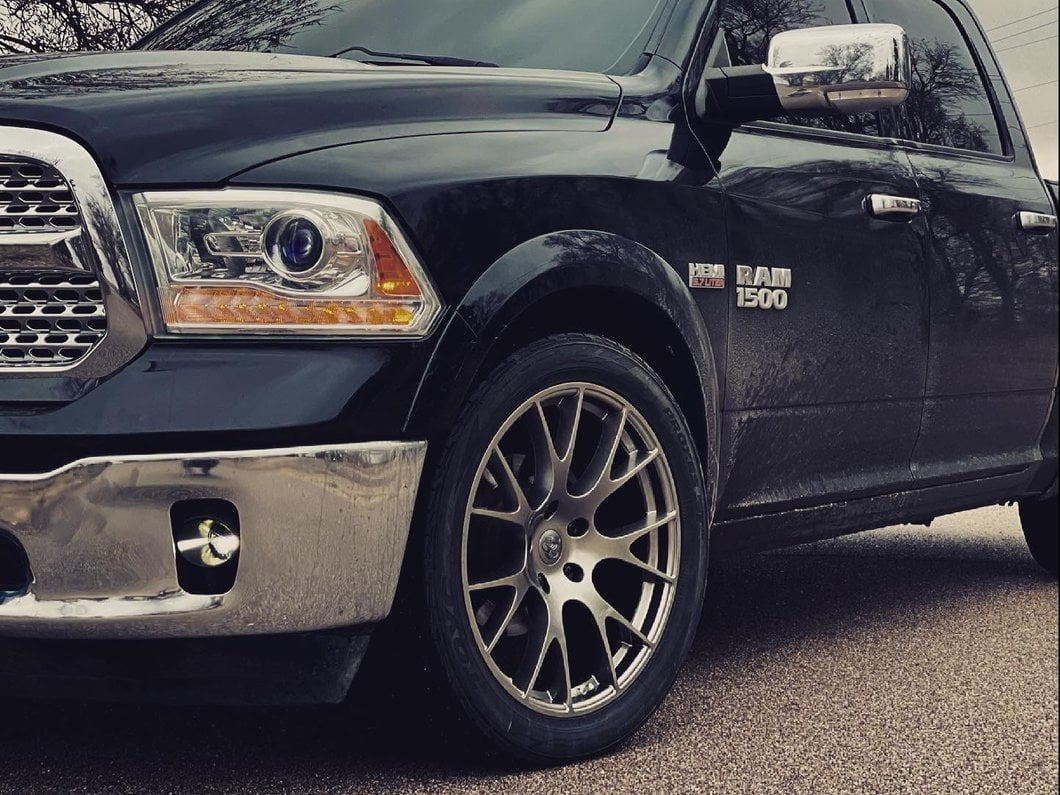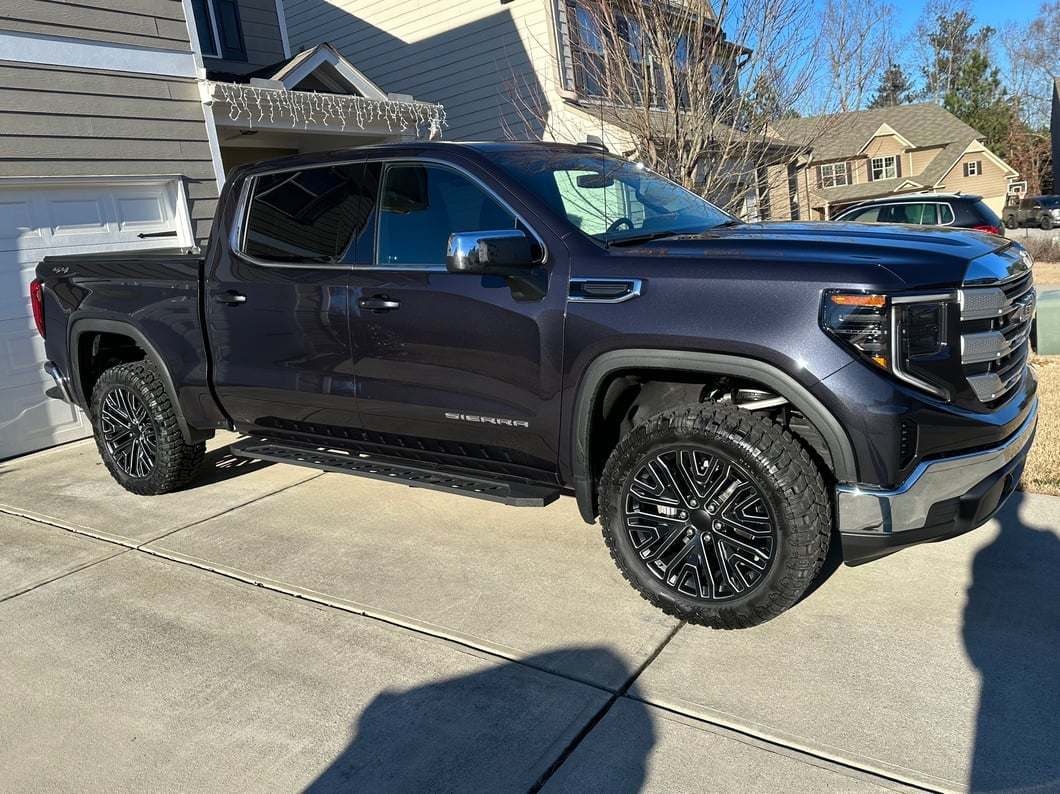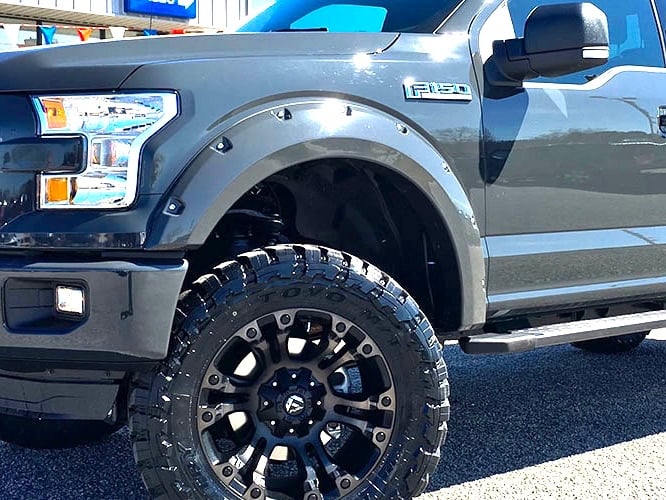Advantages of Upgrading to Larger Rims
You’ll be especially interested in upgrading to larger rims if your truck came from the factory in one of the basic spec builds, which usually means smaller and less stylish wheels, often steel ones. What exactly are the advantages of upgrading to larger aftermarket alloy wheels?

First, there is perhaps the most obvious advantage: style. With aftermarket wheels, you can tailor the looks of your truck to your liking. There are rims that look sporty, and there are others that look upscale and luxurious. Especially if you have modified your truck with a lifted suspension kit, it will really benefit from larger wheels with an aggressive design in a dark finish.
Second, a larger rim also means a larger tire. First of all, this means a wider tread, which can give you more traction on the road and in most cases also in terrain. There are also various profiles for the sidewall, and you have the option of choosing either a higher or lower one. Both of these options come with advantages of their own but for off-the-road use, a higher sidewall is much better. With bigger wheels and tires, your truck will have a higher ground clearance, which helps when going over rough terrain or beds of water. Also, a thick sidewall reduces the chance of curbing your wheels. In short, bigger wheels and tires give you the edge when driving on unpaved roads.
Going further, aftermarket wheels are often lighter, which greatly reduces unsprung mass - that’s a very important factor. Even if you upgrade to a bigger size, the wheels may still be lighter or at least comparable to the small stock rims. At the same time, if you go with a renowned manufacturer like Arkon Off-Road or Fuel Wheels, the wheels will be less prone to cracking and bending than OEM, despite their lower weight.

Impact of Tire Size on the Truck Ride
Above, we’ve outlined some of the advantages of larger rims and tires but it's not all black and white. Some drivers will appreciate a bigger wheel with a low profile tire but others will find them unusable and would much rather opt for a thin tread with a high sidewall on a smaller rim. What’s right for you?
The discussion about tires can be divided into two aspects: tread and sidewall. With a wider tread, your truck will have better traction, be more planted on the road, and offer better braking performance. At the same time, it decreases fuel efficiency and makes the vehicle less able in snowy conditions.

Moving onto the sidewalls, a lower profile sidewall is for sure more aesthetic, and improves handling in the corners, as the sidewall does not deform so much under load while cornering. On the other hand, if you’re after offroading capabilities, then a higher sidewall will work better. A high profile tire flexes more, giving you more potential traction on uneven surfaces. It also improves the ride comfort by absorbing impacts better and protects your rims from curbs when driving in the city and from stones and ridges when off the road.
With the above in mind, there comes a certain point where an even wider tread or higher sidewall does not offer the desired advantages anymore. For example, if you choose a tread that’s too wide, the wheels will become too heavy, thus hindering acceleration, and they will also make the wheels harder to turn. In other words, there are certain limits to how big you can and should go with your wheels, and where you simply trade usability for extra style.
Generally, it‘s best to stick to wheel sizes that are recommended by the manufacturer or slightly larger, unless you’re looking for some specific characteristics, and are willing to make certain trade-offs because of it. With a Ford Raptor or another capable off-road truck, you’re likely to be able to fit tires as big as 35 inches but it's not a very good option unless you’re strictly considering the design aspect. The bottom line is that bigger wheels are an advantage but make sure to stay within reasonable limits.
Wide Selection of Truck Wheels
What kind of wheels are out there? At the very basic level, we distinguish between steel and alloy wheels. Steel wheels are typical for base truck configurations and are typically quite heavy, small, prone to rusting, and not so stylish. The vast majority of aftermarket options are made of alloy, which doesn’t suffer from these cons.
When it comes to alloys, you’ll be able to choose from many designs and colors - silver, chrome, black, gunmetal, bronze, and more. Most manufacturers offer each wheel model in multiple color variants, giving you plenty to choose from.

What’s more important, you’ll need to think about the offset of the wheel. The higher the offset, the more the wheel will protrude from the wheel arch. In terms of compatibility, it's a must to verify that the bolt pattern of your desired wheel is compatible with your truck’s hubs.
If you’re now interested in improving your truck’s ride and style, we have wheels and tires from renowned manufacturers at favorable prices, as well as wheel accessories including lug nuts, spacers, and TPMS sensors. Plus, AmericanTrucks sales techs will be happy to help you choose the right product and answer any questions you might have.





